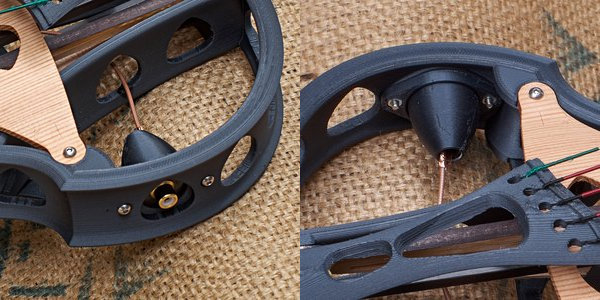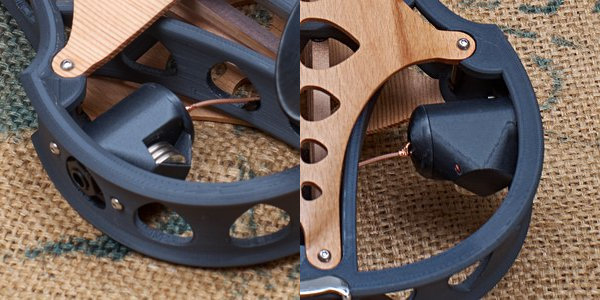26 Sep 2021tags: improvements construction design resonance A new version with incremental but important improvements.
I am currently building two of my latest version of the Sycorax.
There are several changes and improvements.
- Added a smooth curve where the neck and pegbox join. This will improve strength, and may also feel nicer, although it isn't an area you usually touch while playing.
- Added a carbon fibre rod through the neck/pegbox join and partway up the back of the pegbox, to make that area much stronger.
- Removed the fingerboard support that was added in the 2020 model, as I felt that the resonance created from the projection of the fingerboard is beneficial to the tone, and was being eliminated by the fingerboard support. However I have added a fingerboard support at the neck join that extends a short way under the fingerboard, while still allowing most of the fingerboard length to vibrate.
- I now coat the inside of the pegbox with an epoxy / carbon fibre powder mix for strength.
- Changed the print slicing software, so the printed parts make use of some more sophisticated settings and should be stronger.
- Printing at a hotter temperature, for better layer adhesion and greater strength. This currently causes some minor imperfcetions in the surface finish, but I think the stringth is more important.
25 Sep 2021tags: update The Sycorax has not been abandoned!:
I was a bit burned out and took a long break from active development on the Sycorax during late 2020 and early 2021.
I've been thinking through the next steps, and more announcements will follow.
Covid meant no-one had any gigs or money for a while, and Brexit has effectively cut me off from European customers, so things have been slow.
Nevertheless the Sycorax is still very much alive. You can buy one right now.
more soon!
17 Feb 2020tags: design construction improvements Since the initial release of the Sycorax I have made quite a few changes. Some are tiny and not worth mentioning here and some are more significant.
Changes in "late 2019" model:
The "late 2019" instruments are the earliest ones I still have for sale and they are being sold at a discount. They are not all identical since I was trying out a few slightly different designs, but they are all similar and all the things I tried worked much the same. The changes for these included:
- Inner brace moved to give more clearance from top.
- Extra carbon fiber bracing in body and neck to stiffen the neck joint.
- Still built with a bolt on neck, but they have all now been glued as well to be sure (to be sure).
- Three different widths of pegbox were tried. All work fine but these models do vary in pegbox width.
- Changed the output jack design to use a RCA connector on the pickup side.
Further changes in Feb 2020 model:
- Settled on the medium pegbox width as standard (slightly narrower than the original).
- Neck joint re-designed from scratch to be glued on with a carbon rod from the body extending into the neck - so super stiff and strong.
- Fingerboard support added that ties in the fingerboard to the body, further stiffening the neck joint and upper body frame.
- New top and back design with greater arching and more holes for more predictable response and greater feedback resistance.
- Top and back woods now usually european spruce for the top and maple for the back, though other woods may sometimes be used.
- Moved to using phenolic for nuts instead of ebony (I am trying to eliminate all use of restricted species). Some chinrests are still ebony, but these are easily replaceable. I haven't yet found a suitable affordable, high quality, black chinrest that isn't ebony. I do have boxwood chinrests though they don't match visually so well.
- Reinforced the neck to pegbox joint with an additional carbon fibre rod (this was also done in a slightly different way as a retrofit to most of the 2019 instruments).
Gallery of Feb 2020 Version
17 Apr 2019tags: jack level output battery The sycorax electric violin output jack is mounted on a separate piece that can be changed in about 10 minutes.
I call this piece a pod and it contains the jack and any electronics that may be required.
I have made this as a modular part so that I can easily offer different options for the output electronics and jack, and so that players can even change from time to time as suits them.
It wouldn't be practical to change the pod in the middle of a gig, but it is certainly practical to change the pod to suit a particular setup that you might be using for a while - for example on a tour.
So far there are two options:
- A passive RCA jack that can be used with the violorama phantom powered preamp cable.

- A battery powered (3x CR2032) pod with a 1/4" jack that can be used with a standard guitar cable (or preferably a lightweight jack cable).

Other options are certainly possible, for example a passive jack output would be no problem, but I don't currently see much need for it. The two options above are what I have ready so far.
Each of the options is convenient in a different situation.
This may be best expressed as a list of pros and cons of each setup.
RCA passive pod + violorama preamp cable
This is my personal preferred option.
Pro:
- lightweight
- no batteries to go flat if used with the violorama phantom powered preamp cable
- simplest possible option on the violin itself.
- violorama preamp cable has excellent sound and very high headroom
- can be used with other external preamps if needed
- preamp can be changed in seconds in the event of an electronics fault
- doesn't require a DI box to plug into a mixer
Con:
- requires a custom cable such as the violorama preamp cable
- to use it with a jack input such as pedals, requires an extra box on the floor to provide power to the preamp. This can have extra features added however such as volume or footswitchable mute etc.
Battery powered preamp pod with jack output
Pro:
- works with any standard guitar cable - convenient for using pedals
- self contained preamp with an output similar to other instruments - ie it is more what people are used to.
Con:
- batteries go flat and need replacing from time to time
- slightly less headroom than the violorama preamp cable (not normally noticable)
- requires a DI box to plug into a microphone input. Can be plugged into a mixer line input but performance may vary depending on the mixer specs.
- preamp less quick and easy to swap out if required (ie not during a gig)
Older

